Opening up a section of ride.
A quick snapsnot of what Mrs Treedom and I did on 28th of August 2023 with a chainsaw, a brush cutter and a couple of hours.
A ride is the woodland vernacular for a path-like route through the woodland. Over the course of this year we've been strategically opening up many of the rides created by wildlife as well as creating rides to help us navigate the woodland. Although I’ve documented it all on photos and recorded the works as part of the woodland management plan I’ve not really shared much about the process here.
On August bank holiday, Mrs Treedom and I managed to make a few hours of time to escape to the woodland to do a little bit of work. I did some work on the car park stairs (an in progress project and an upcoming video and post) leading into the woodland, but we spent the most of the time clearing up a section of ride that I started back in May, but for some reason, didn’t finish.
Here’s a sketch of the woodland as it is today. The rides are the peachy lines and our amenity areas are outlined in black. I’ll go into the specifics of the amenity areas in the future as I don’t want to go too off-topic. Nothing on this little sketch is “to scale” and locations are approximate. The section of ride Mrs Treedom and I cleared was the area to the camp which I’ve highlighted in a green line.
When doing rides you’re supposed to have them meander and avoid straight lines. I understand this is to provide shelter and cover for wildlife. However, lawyers and surveyors don’t consider such things and when our woodland was sectioned out, we ended up with a square. So not surprisingly, we’ve got a straight ride going all the way around the boundary. However, the rides that connect our amenity areas are very “meandery” and whilst this is for wildlife it is also for us. There’s something about meandering around curves that isn’t present on a straight line. Meandering tends to be about the journey. Straight lines tend to be about the destination.
I never take pleasure in felling a tree for a highway and I didn’t buy a woodland to clear-fell the place. However there’s no avoiding the occasional removal of a birch tree and there’s certainly no avoiding pruning lower branches - especially holly 😡. So when selecting a route for the ride, the aim is to balance the path that has the least impact in terms of removal, with the path that is most pleasurable to meander down whilst doing your best to align with your management plan.
The ride we were working on was half done by myself back in May. However when I got to this section, I stopped. I cannot tell you why, but I did. And this dear reader, is where Mrs Treedom and I picked up.

The first order of business was to take care of the two young, diseased and leaning birch trees. The one on the right was dead and the one in the middle was doing the thing that birch does - grows towards the light. The problem with that is that birch is very good at getting the light and it shades out everything else – especially oak saplings. This area has particularly good natural oak regeneration (even though the deers are eating it all – for now…) and so I want to get as much light onto the ground as possible. One of the long term aims for Treedom woods is to alter the composition of the woodland from mostly birch with a lot of mature oak, to mostly mature and young oak with some birch. That however is a long term goal, but it is why I don’t ever feel bad about thinning low quality birch trees like these.
Once the tree was down, we were at a small holly thicket. I didn’t get any before pictures because I always tend to get lost in the work and forget about capturing the before picture. Suffice to say this area of the woodland has a lot of holly and it is an angry thing to work with. It always makes you aware of its presence. Once we were through that holly though I did get a before and after picture of the next section.
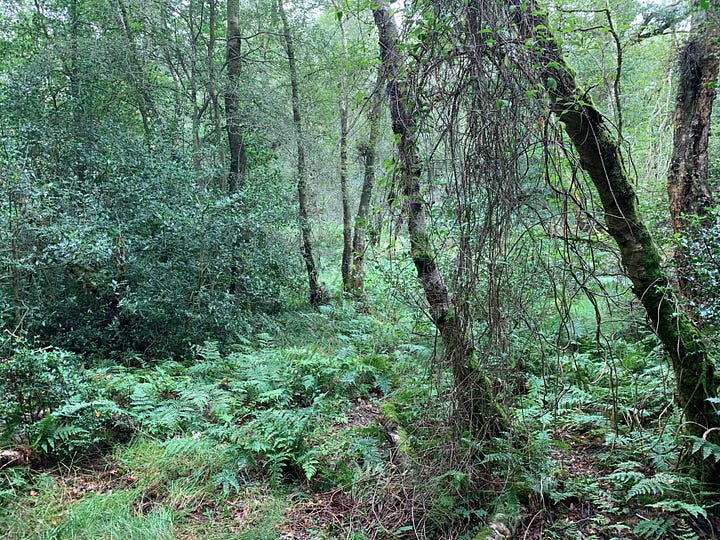
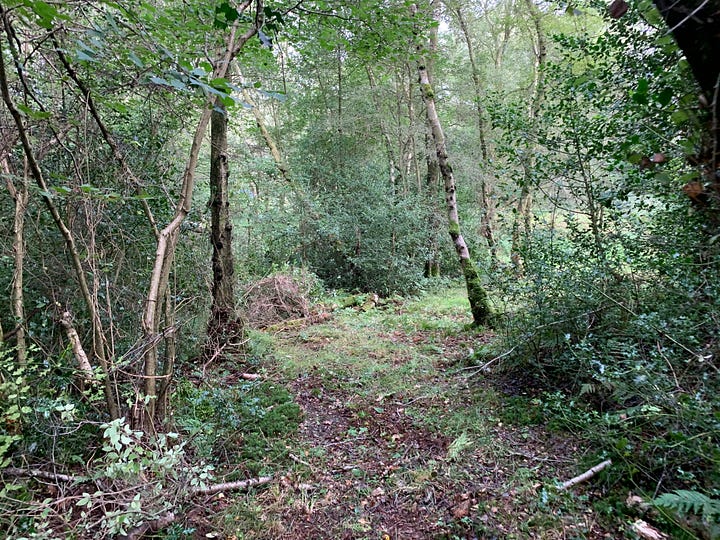
I always feel like the before pictures have the better vibe than the after pictures and this is especially true in areas that holly and bracken have been present. There’s a certain green-ness to the bracken floor when mixed with the deep green of holly. However, when you’re in the woodland, it isn’t that nice or practical. For one, the bracken and high grass is laced with ticks. Obviously, you want to reduce the chance of being bitten by ticks because deer and ticks means the presence of Lymes disease. Secondly, whilst the photos look great, when you’re in an area that hasn’t been cleared it has a fairly oppressive feeling to it. Like it has been abandoned and left for dead. Of course, by removing stuff at the ground layer, field layer and canopy layers I am ultimately scarring and removing healthy green life, but I am also creating space for new, managed life to spring into existence. As they say, the piper always needs to be paid.
As we moved through the thicket we came out the other side and into more open area that sloped down into a very clogged up water course. There are a lot of these clogged up water courses and I am sure they’re contributing to a lot of the bogginess of the woodland in some areas. Weirdly, the boggy areas tend to look the prettiest as the grass is always a deep vivid green. Boggy areas make for great photos, but they are awful for passage and useless for leisure. The drainage in these places will need attention as we have a few rides that get boggy. They’ll need some kind of french drain system installing which in a limited few places I will do by hand.
Above you can see that Mrs Treedom has made it to the other side of the water course. For the larger “woodland wide” water course clearing, I am absolutely going to do that with machinery. I’m all for hand tools, but I’m not a luddite. Machines have power and speed. Chainsaws and brush cutters being great examples of machines I use frequently, but there’s always room for my silky for smaller, ad-hoc work. But for large projects in which I will be moving tonnes of earth, I’ll go with machinery and save not only precious time, but also my precious back. There’s no way I’m doing anything where the distance can be summarised in miles by hand.
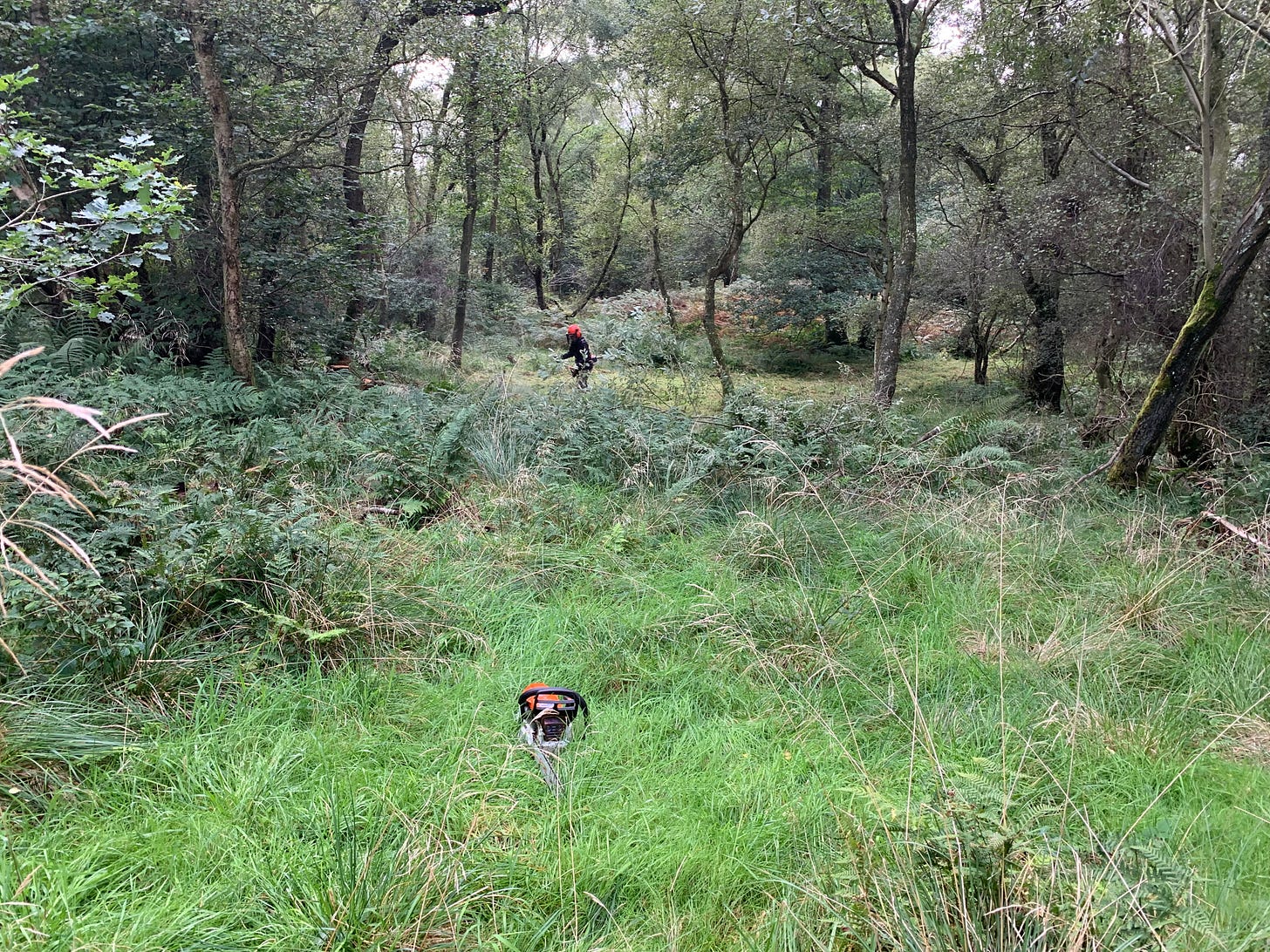
We found a nice rhythm as we worked. I tended to go ahead with the saw and decide on the path forward. My decisions being based on longer term management goals. Always stay away from the young oaks, ideally go through open space, but if you have to remove something, then aim for smaller, low quality malformed birch or trees that are being killed by ivy. Never cut the hawthorn - the faeries don’t like it and you don’t want to piss the fae off. Especially in a woodland in which you climb trees.
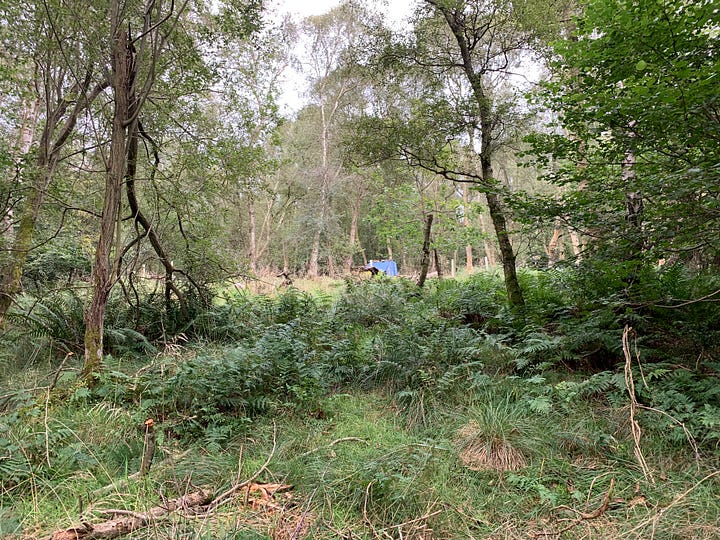

In the above photos we’re looking up towards the camp. On the left we have the before picture in which you can see ivy choked trees with snapped limbs hanging. On the right, we have a cleared space where the trunks and branches have been laid on the ground to naturally degrade, creating a nice boundary to the open ride. I cannot wait until that pile of larch under the blue tarp is finally transformed into a camping platform. I especially cannot wait to wake up early after a camp, get dressed and go for a morning walk in the woods. Enough dreaming – back to reality.
It took us both about two hours in total to clear this ride. I think there’s one more ride left to establish in the woodland and then we’re done defining all the major sub-compartments. This final stretch of ride will be from the camp to three oak grove which you can see from the sketch is currently missing. Don’t be fooled into thinking that all the work is done once this final ride is place. These rides need maintaining on a non-stop basis because they’re grass that has a lot of bracken in it. This means that for a good few years, about 2 kilometres of 2-5 metre wide ride needs brush cutting at least every three weeks from May - October in order to keep the grass and bracken down. We’re going to line the rides with dead hedging as that is a great way to use up the arising from all the tree work to support the local ecology.
Eventually, when I launch my tree surgery business next year, I’ll begin having an abundance of woodchip which I intend to use as a surface for the rides. This will help massively with keeping them clear of bracken and holly regrowth. For now though, it’s just a case of getting the brush cutter and cracking on every few weeks. “Don’t whinge, do it” kind of thing.
If you want to see the full album of images, you can do so on the flickr album - Treedom Woods 28 Aug 2023.
Thanks for reading,
Cheers,
Jamie


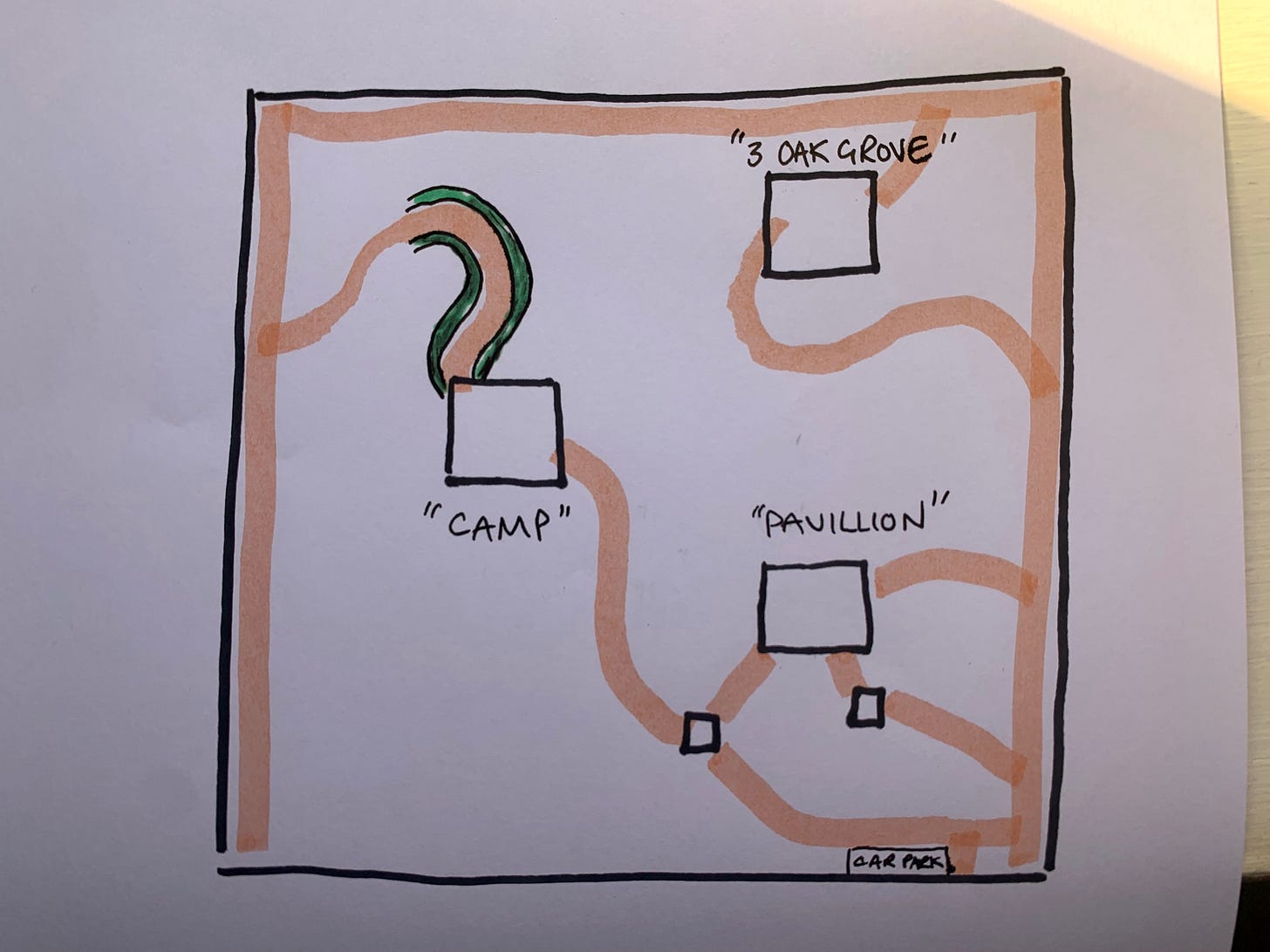
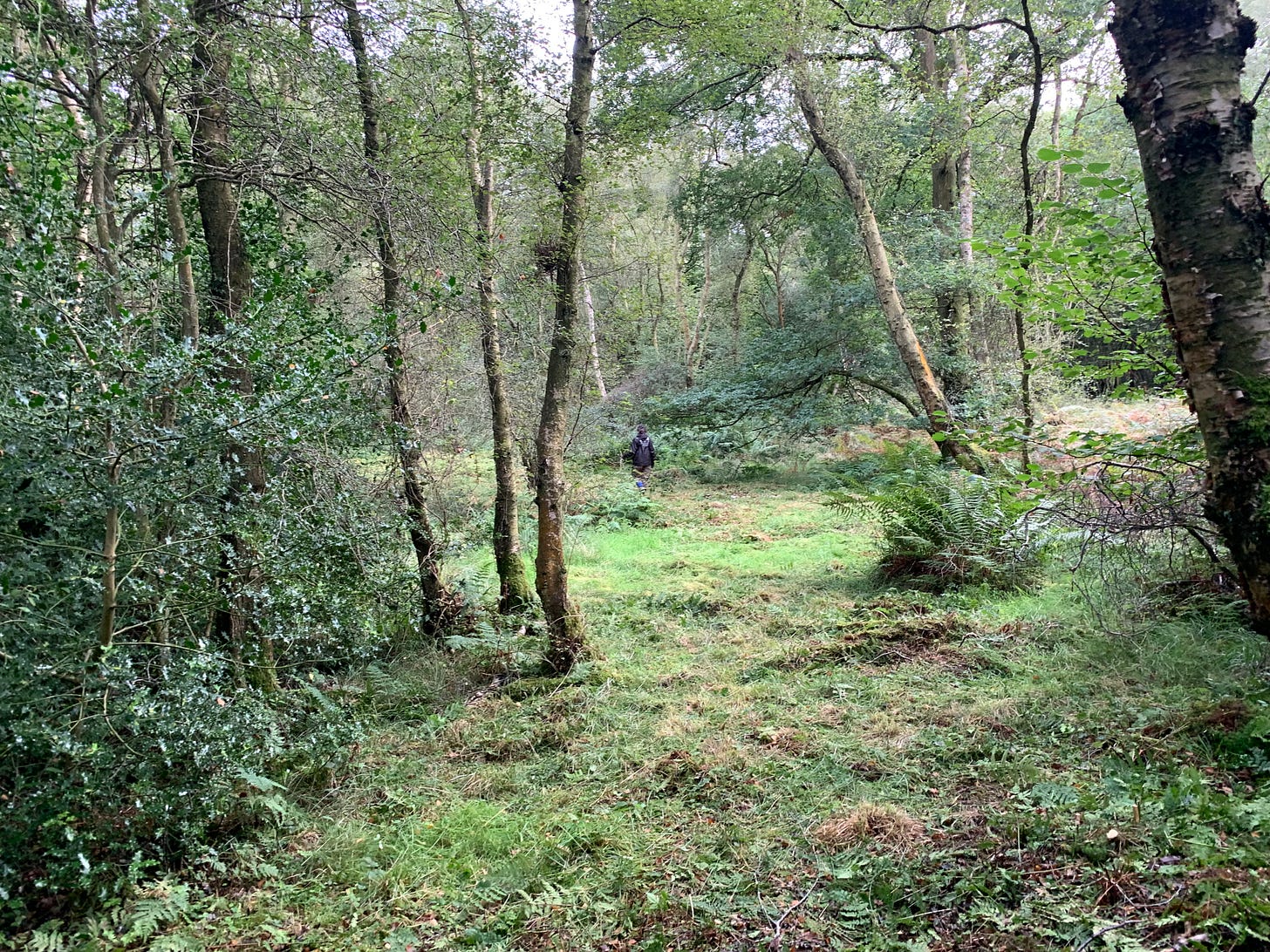
I love it :-)